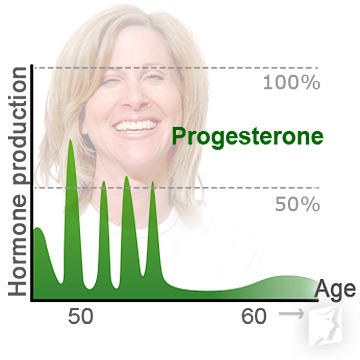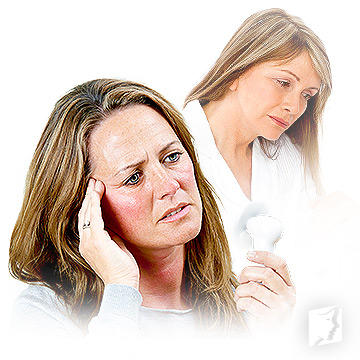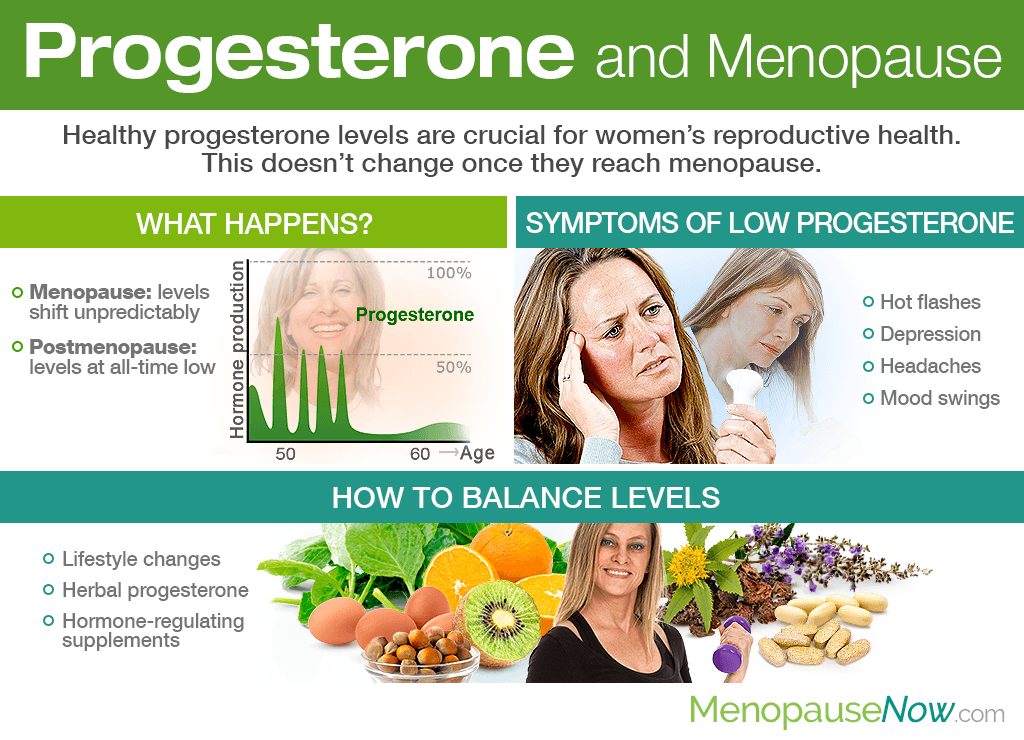Healthy progesterone hormone levels are crucial for women's reproductive and overall health. Accordingly, its imbalance can cause much conflict no matter their age and reproductive stage. Continue reading to learn more about progesterone and menopause, including what happens to progesterone levels mid-life, what are imbalance symptoms, and how to treat it for optimal health.
What Happens to Progesterone during Menopause?

Throughout women's reproductive lives, progesterone levels remain fairly stable, guiding the flow of the menstrual cycle along with estrogen. During this time, the chief producers of progesterone are the adrenal glands during the follicular phase and the ovarian corpus luteum - the remnant of the follicle - during the luteal phase.
Then, as women enter menopause, the ovaries prepare to end reproductive functions, and in the process of doing so, the number and quality of ovarian follicles diminishes. As such, progesterone levels shift erratically as fewer ovulations occur.
With postmenopause, progesterone reaches an all-time low. Peripheral nerves and the adrenal glands, among other organs, take part in contributing to the hormone's production at this time, but levels are at a fraction of what they were during fertile years.
Accordingly, low progesterone during perimenopause and after menopause can evoke many hormonal imbalance symptoms that middle-aged women can be all too familiar with.
Symptoms of Low Progesterone during Menopause

The symptoms of low progesterone during perimenopause shadow many of those seen due to an estrogen imbalance during menopause. They include:
- Hot flashes
- Depression
- Irregular periods
- Loss of libido
- Headaches and migraines
- Anxiety
- Mood swings
- Weight gain
- Breast pain or tenderness
- And more
It is important to remember that estrogen and progesterone balance each other out. It is not uncommon for low progesterone levels to occur in lieu of high estrogen levels, provoking an even wider variety of symptoms not listed.
The most certain way to know your hormonal state is to visit your doctor to receive the appropriate diagnostic tests.
How to Balance Progesterone during Menopause

While many women are pushed to pursue hormone replacement therapy (HRT) - including the use of progesterone creams - when suffering from menopause symptoms, balancing progesterone during menopause can be done with natural methods.
Women are first encouraged to instill less risky approaches, namely lifestyle changes that involve implementing a wholesome diet, regular exercise, and healthy habits into their daily routines. Here are the basics of each:
Wholesome diet. Enrich your diet with foods rich in vitamins B and C as well as the mineral zinc. All can be found in dark, leafy vegetables, whole grains, eggs, dairy products, legumes, nuts, seeds, poultry, and shellfish, while vitamin C is especially abundant in fruits like oranges, cantaloupe, and kiwi. Include all as part of a meal plan consisting of lean protein, healthy fats, and complex carbs.
Regular exercise. Estrogen can be produced by fat cells, further aggravating a progesterone imbalance. As such, participating in regular aerobic, strength training, and weight-bearing exercises will not only help her maintain healthy weight, but also boost mood, de-stress, and promote overall endocrine system health. Strive for 30 minutes a day, five days a week for starters.
Healthy habits. Women suffering from low progesterone during menopause should lower stress levels with yoga, tai chi, meditation, or other techniques as accumulated cortisol has been shown to reduce the hormone's levels. Also, women should strive to quit unhealthy additions (smoking, alcohol, caffeine, etc.) and try to get at least seven to eight hours of restful sleep each night for optimal effects.
For improved results, women should consider the use of alternative medicine traditionally taken to balance progesterone levels during menopause, thus alleviating symptoms of hormonal imbalance. They include:
Herbal progesterone. Chaste tree berry inhibits the pituitary hormone prolactin, thus improving ovulation and progesterone production, while Rhodiola rosea can thwart the conversion of progesterone to cortisol during stressful conditions. Speak with a certified herbalist for correct dosing before beginning a treatment plan.
Hormone-regulating supplements. Hormone-regulating supplements, like Macafem, promote natural hormone production in the body by encouraging the endocrine glands to work more efficiently. Because they do not produce outside hormones into the body, they can be considered one of the safest, long-term options for resolving the hormonal imbalance at fault for symptoms of low progesterone in menopause.
Conclusions
While the decline of reproductive hormones such as progesterone is inevitable as women age, they do not have to suffer through the consequences of the imbalance for years to come. With certain natural and effective menopause symptoms treatments that focus on a balance of lifestyle changes alongside the use of aforementioned alternative medicine, it is possible to live a symptom-free lifestyle far into one's twilight years.
Sources
- Cleary, M.P. & Grossmann, M.E. (2009). Obesity and Breast Cancer: The Estrogen Connection. Endocrinology, 150(6), 2537-2542. doi: 10.1210/en.2009-0070
- Harvard Health Publishing. (2018). Perimenopause: Rocky road to menopause. Retrieved June 25, 2019, from https://www.health.harvard.edu/womens-health/perimenopause-rocky-road-to-menopause
- Healthy Women. (n.d.). Low Progesterone Symptoms. Retrieved June 25, 2019, from https://www.healthywomen.org/content/article/low-progesterone-symptoms
- Mesen, T.B. & Young, S.L. (2015). Progesterone and the Luteal Phase. Obstetrics and Gynecology Clinics of North America, 42(1), 135-151. doi: 10.1016/j.ogc.2014.10.003
- PeaceHealth. (2015). Vitex. Retrieved June 25, 2019, from https://www.peacehealth.org/medical-topics/id/hn-2181002
- Society of Endocrinology. (2015). Progesterone. Retrieved June 25, 2019, from http://www.yourhormones.info/Hormones/Progesterone.aspx

